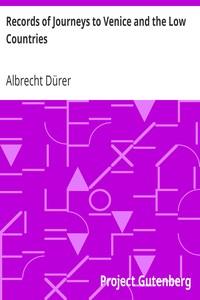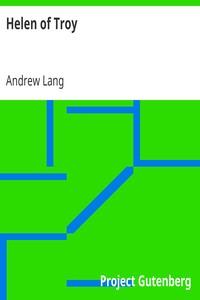Read this ebook for free! No credit card needed, absolutely nothing to pay.
Words: 24672 in 5 pages
This is an ebook sharing website. You can read the uploaded ebooks for free here. No credit cards needed, nothing to pay. If you want to own a digital copy of the ebook, or want to read offline with your favorite ebook-reader, then you can choose to buy and download the ebook.


: Records of Journeys to Venice and the Low Countries by D Rer Albrecht Tombo Rudolf Translator - Artists Germany Correspondence; Artists Germany Diaries; Venice (Italy) Description and travel; Netherlands Description and travel; Dürer Albrecht 1471-1528 Tr
BASIC BACKGROUND
Albrecht D?rer was probably the greatest graphical artist of the Northern Renaissance. He is the first to have elevated the self-portrait to a high art form, and was known for his fascination with animals, which form the subjects of many of his graphical works. He reveled in portraying men of learning and/or high stature as well as peasants, believing that portraits of the latter could be as instructive as those of the former. His marriage to his wife Agnes was childless and banal, apparently because D?rer was too preoccupied with intellectual matters to be much interested in romantic pursuits.
In the letters below, this unusually modern thinker demonstrates his noble, righteous utilitarian personal philosophy, and meticulously records his personal and travel expenses, while journeying throughout Venice and various other European cities and divided German states. Numerous kings and laypeople sought to meet and host him, since he was renowned and loved as a painter while still alive. He comments on Martin Luther, Erasmus of Rotterdam and painting, and demonstrates his curious, inquiring nature. He also describes his visit to Zeeland to see a beached whale, which washed away before he got there; but during this visit, D?rer may have caught the disease from which he may have died several years later. Like Rembrandt, he enjoyed collecting things, and demonstrates this in his letters.
BRIEF EXCERPT FROM THE INTRODUCTION TO THE 1913 EDITION, WRITTEN BY ROGER FRY :
Whatever one's final estimate of his art, D?rer's personality is at once so imposing and so attractive, and has been so endeared to us by familiarity, that something of this personal attachment has been transferred to our aesthetic judgment. The letters from Venice and the Diary of his journey in the Netherlands, which form the contents of this volume, are indeed the singularly fortunate means for this pleasant intercourse with the man himself. They reveal D?rer as one of the distinctively modern men of the Renaissance: intensely, but not arrogantly, conscious of his own personality; accepting with a pleasant ease the universal admiration of his genius-a personal admiration, too, of an altogether modern kind; careful of his fame as one who foresaw its immortality. They show him as having, though in a far less degree, something of Leonardo da Vinci's scientific interest, certainly as possessing a quick, though naive curiosity about the world and a quite modern freedom from superstition. It is clear that his dominating and yet kindly personality, no less than his physical beauty and distinction, made him the center of interest wherever he went. His easy and humorous good- fellowship, of which the letters to Pirkheimer are eloquent, won for him the admiring friendship of the best men of his time.
To all these characteristics we must add a deep and sincere religious feeling, which led him to side with the leaders of the Reformation, a feeling which comes out in his passionate sense of loss when he thinks that Luther is about to be put to death, and causes him to write a stirring letter to Erasmus, urging him to continue the work of reform. For all that, there is no trace in him of either Protestantism or Puritanism. He was perhaps fortunate--certainly as an artist he was fortunate--to live at a time when the line of cleavage between the reformers and the Church was not yet so marked as to compel a decisive action.
CAST OF CHARACTERS:
Agnes: D?rer's wife Wilibald Pirkheimer: D?rer's best friend Wolgemut: The master painter to whom D?rer began formal training as an apprentice. Later, D?rer painted a richly detailed self-portrait of him. Giovanni Bellini: Famous Renaissance painter and contemporary of D?rer. Jan van Eyk: Famous Renaissance painter. Imhof: Hans Imhof, the elder, at Nuremberg; the younger Imhof was in Venice. Schott: Kunz Schott, an enemy of the town of Nuremberg. Weisweber: A Nuremberg general.
FORMS OF MONEY REFERRED TO IN THE LETTERS:
PART 1: LETTERS FROM VENICE TO WILIBALD PIRKHEIMER
Venice, 6th January, 1506
To the Honourable and wise Wilibald Pirkheimer, in Nuremberg.
Free books android app tbrJar TBR JAR Read Free books online gutenberg
More posts by @FreeBooks

: Mr. Honey's Work Study Dictionary (German-English) by Honig Winfried - English language Dictionaries German; German language Dictionaries English


: Mr. Honey's Correspondence Dictionary (English-German) by Honig Winfried - English language Dictionaries German; German language Dictionaries English






